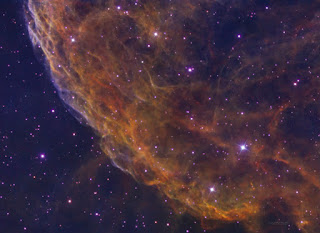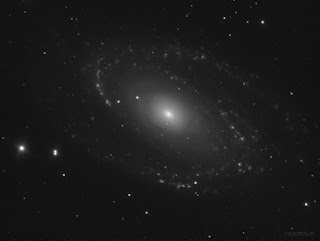Saturday, December 29, 2012
M1 Crab Nebula
The Crab Nebula is a supernova remnant in the constellation of Taurus. The nebula was observed by John Bevis in 1731; it corresponds to a bright supernova recorded by Arab, Chinese and Japanese astronomers in 1054. Total of 18.5 hour exposure taken through emission line filters.
Saturday, November 24, 2012
IC434
Optics: Deep
Sky Instruments RC10C
Mount: Astro-Physics
AP900GTO
Camera: SBIG
ST2K XM
Guiding
Camera: SBIG ST-i
Filters
Astrodon S2, Ha & O3
Location: Deerlick Astronomy
Village & Roswell Georgia
Exposure
Details
S2
= 660 Minutes (mapped to red)
Ha
= 405 Minutes (mapped to green)
O3
= 210 Minutes (mapped to blue)
All
sub-exposures were 15 Minutes.
Wednesday, September 26, 2012
NGC7000
After raking the fall leaves as a small boy I use to
spend time daydreaming and looking at the clouds - forming familiar shapes of
animals and objects - usually from the books that I was reading or from places
we visited. The same way I use to
daydream as a child – I find myself “night” dreaming while at the telescope. This one reminds me of a palm tree bending in
the oceans breezes. As an “older” boy
now it is nice to remember those younger days.
This photograph is a small 22 x 30 arc minute view of
the North America Nebula. NGC7000 is a emission nebula located in the constellation
Cygnus close to the star Deneb and about 1800 light years distance. This
dim nebula is quite large covering an area larger than four full moons and was
discovered by William Herschell on October 24, 1786.
Optics: Deep
Sky Instruments RC10C
Mount: Astro-Physics
AP900GTO
Camera: SBIG
ST2K XM
Guiding
Camera: SBIG ST-i
Filters
Astrodon S2, Ha & O3
Location:
Two
Part Mosaic Total Exposure Details
S2
= 1440 Minutes (mapped to red)
Ha
= 300 Minutes (mapped to green)
O3
= 1050 Minutes (mapped to blue)
All
sub-exposures were 15 Minutes.
Total
Exposure Time 46.5 Hours
Tuesday, August 14, 2012
NGC 6888
It was wonderful to see the stars the last few nights. The air was calm, cool with low humidity, the skies steady – perfect weather for imaging!
The Crescent Nebula (also known as NGC 6888, Caldwell 27, Sharpless 105) is an emission nebula in the constellation Cygnus, about 5000 light years away from our home planet. .
Optics: Deep
Sky Instruments RC10C
Mount: Astro-Physics
AP900GTO
Camera: SBIG
ST2K XM
Guiding
Camera: SBIG ST-i
Filters
Astrodon Ha and O3
Location: Roswell, Georgia
Exposure
Details:
Ha
= 330 Minutes (mapped to red)
O3
= 480 Minutes (mapped to blue & green)
Friday, July 20, 2012
NGC4725
As the weather continues to be “Stormy” along the
southeast, my hopes of finishing this picture are dwindling. Looks like I’ll add it to the list of shots
to complete on the spring next year. NGC 4725 is an intermediate barred spiral galaxy about 40
million light-years away from our home planet in the constellation Coma Berenices.
Optics: Deep
Sky Instruments RC10C
Mount: Astro-Physics
AP900GTO
Camera: SBIG
ST2K XM
Guiding
Camera: SBIG ST-i
Filters
Astrodon Ha & Luminance
Location: Deerlick
Astronomy Village & Roswell, Georgia
Exposure
Details
Ha
= 840 Minutes
Thursday, July 5, 2012
NGC6992
The eastern portion (NGC 6992) of the Veil Nebula is
a cloud of heated and ionized gas and dust in the constellation Cygnus. This four picture mosaic only represents a
small portion of this wonderful area of the sky.
Optics: Deep
Sky Instruments RC10C
Mount: Astro-Physics
AP900GTO
Camera: SBIG
ST2K XM
Guiding
Camera: SBIG ST-i
Filters
Astrodon Ha and O3
Location: Roswell, Georgia
Exposure
Details:
Four
part mosaic - Total exposure time of 27.5hrs
Ha
= (mapped to red)
O3
= (mapped to blue & green)
Thursday, April 26, 2012
M51
M51 (Whirlpool Galaxy) and its companion
NGC5195 galaxy are located 23 million light years away in the constellation
Canes Venatici. The red/pink areas of
the galaxy are star forming HII regions.
Optics: Deep Sky Instruments RC10C
Mount: Astro-Physics AP900GTO
Camera: SBIG ST2K XM
Guiding Camera: SBIG ST-i
Filters Astrodon S2, Ha & O3
Location: Deerlick Astronomy Village & Roswell
Georgia
Exposure Details
Ha = 435 Minutes (mapped to red)
L = 310 Minutes
RGB = 200 Minutes Bin 2x2
Wednesday, April 25, 2012
M16
Lots of wind and cold
weather at DAV this weekend, but I was finally able to get enough data to
finish M16.
Young star cluster M16 is surrounded by
clouds of cosmic dust and glowing gas also known as The Eagle Nebula. The Eagle Nebula is
part of a diffuse emission nebula, or H II region, which is catalogued as IC
4703. This region of active current star formation is about 6,500 light-years
distant in the Constellation Serpens.
Optics: Deep Sky Instruments RC10C
Mount: Astro-Physics AP900GTO
Camera: SBIG ST2K XM
Guiding Camera: SBIG ST-i
Filters Astrodon S2, Ha & O3
Location: Deerlick Astronomy Village
Exposure Details
S2 = 240 Minutes (mapped to
red)
Ha = 195 Minutes (mapped to
green)
O3 = 165 Minutes (mapped to
blue)
All sub-exposures were 15
Minutes.
Friday, April 20, 2012
NGC2237
Radiation from young stars
in NGC2237 makes the nebula shine by exciting its atoms to emit radiation.
The dark nebula, consisting of cooler gases and dust, is highlighted against
this glowing background. This picture is
a small 22’x16’ arc minute view of a portion of the Rosette Nebula located
5,200 light years away from our home in the Constellation Monoceros.
Optics: Deep Sky Instruments RC10C
Mount: Astro-Physics AP900GTO
Camera: SBIG ST2K XM
Guiding Camera: SBIG ST-i
Filters Astrodon S2, Ha & O3
Location: Roswell, Georgia
Exposure Details
S2 = 345 Minutes (mapped to
red)
Ha = 180 Minutes (mapped to
green)
O3 = 180 Minutes (mapped to
blue)
All sub-exposures were 15
Minutes.
Thursday, April 12, 2012
M76
The Little Dumbbell Nebula,
also known as Messier 76, is a planetary nebula located 2,500
light years away in the constellation Perseus.
Optics: Deep Sky Instruments RC10C
Mount: Astro-Physics AP900GTO
Camera: SBIG ST2K XM
Guiding Camera: SBIG ST-i
Filters Astrodon Ha, O3, Red, Green and Blue
Location: Roswell, Georgia
Exposure Details
Ha = 510 Minutes (mapped to
green)
O3 = 360 Minutes (mapped to
blue)
RGB = 30 Minutes for Star Color
Friday, April 6, 2012
M82
Messier 82 (also known as NGC
3034, Cigar Galaxy or M82) is a nearby starburst galaxy
about 12 million light-years away in the constellation Ursa Major.
Optics: Deep Sky Instruments RC10C
Mount: Astro-Physics AP900GTO
Camera: SBIG ST2K XM
Guiding Camera: SBIG ST-i
Filters Astrodon: Luminance, Red, Green and Blue
Location: Deerlick Astronomy Village
Exposure Details
L = 210 Minutes
RGB = 240 Minutes Bin 2x2
Ha = 540 Minutes (mapped to red
Friday, March 30, 2012
M13
M13 is a Globular Cluster of about
300,000 stars located in the constellation Hercules.
Optics: Deep Sky Instruments RC10C
Mount: Astro-Physics AP900GTO
Camera: SBIG ST2K XM
Guiding Camera: SBIG ST-i
Filters Astrodon: Luminance, Red, Green and Blue
Location: Deerlick Astronomy Village
Exposure Details
L = 210 Minutes
RGB = 260 Minutes Bin 2x2
All sub-exposures were 10
Minutes.
Monday, March 5, 2012
IC443
IC443 is a super
nova remnant located about 5,000 light years away in the constellation Gemini.
Optics: Deep Sky Instruments RC10C
Mount: Astro-Physics AP900GTO
Camera: SBIG ST2K XM
Guiding Camera: SBIG ST-i
Filters Astrodon S2, Ha & O3
Location: Roswell, Georgia
Exposure Details
S2 = 240 Minutes (mapped to
red)
Ha = 345 Minutes (mapped to
green)
O3 = 360 Minutes (mapped to
blue)
All sub-exposures were 15
Minutes.
Thursday, February 2, 2012
SH2-252
SH2-252 is
an emission nebula located about 6,350 light years away in the constellation
Orion.
Optics: Deep Sky Instruments RC10C
Mount: Astro-Physics AP900GTO
Camera: SBIG ST2K XM
Guiding
Camera: SBIG ST-i
Filters
Astrodon S2, Ha & O3
Location: Roswell, Georgia
Exposure
Details
S2 = 420
Minutes (mapped to red)
Ha = 270
Minutes (mapped to green)
O3 = 255
Minutes (mapped to blue)
All
sub-exposures were 15 Minutes.
Sunday, January 29, 2012
M97
M97 also known as the “Owl Nebula” is a planetary nebula located
in the constellation Ursa Major.
Optics: Deep Sky Instruments RC10C
Mount: Astro-Physics AP900GTO
Camera: SBIG ST2K XM
Guiding
Camera: SBIG ST-i
Filters
Astrodon Ha & O3
Location: Roswell, Georgia
Exposure
Details
Ha = 240
Minutes (mapped to red)
O3 = 195
Minutes (mapped to blue and green)
Thursday, January 5, 2012
Subscribe to:
Comments (Atom)
















